Woodwork that includes doors, windows, cupboards, finishing works plays a vital part in the construction.
Woodwork is frequently attacked and damaged by termites, mostly by white ants that fed on wood and other cellulosic materials like textiles, paper and cardboard.
Sometimes, white ants may also damage non-cellulosic materials like plastic, leather and rubber. Hence, it is essential to treat the building with termite-proofing to protect household things like furniture, cupboards, finishing’s, clothing and paper.
Types of Termites
Based on the habitat, termites are of two types -
Ground-nesting termites: These are also known as subterranean termites, found in places with adequate moisture. They found in all regions of India and always maintain a connection with the soil and form soil tubes, or tunnels, through which they make a route into buildings.
They form secondary nests in the wood and eat all cellulosic materials like paper, cardboard and clothes along with wood.

Drywood termites: These termites need humid conditions and live on wood without maintaining any connection with the soil. They live in small colonies and mostly found in coastal regions of South India.
Principles of Termite Proofing
The general principles should be observed while constructing a building termite-proof is as follows:
- Suitable treatment of termite-proofing should be given to the building during the construction itself.
- Ensure adequate site drainage by providing impervious slab (concrete/stone) below the rainwater pipes to drain away rainwater.
- Provide Flagging concrete around the building.
- The filling material used for foundation gap and plinth should be treated with termite-proof chemicals.
- Make floor joints termite proof with the use of suitable joint fillers or metal strips.
- Proper care should be taken to avoid a gap or bridge between any part of the building and untreated soil.
Termite Proofing Materials
Chemicals for anti-termite treatment available in the market under the brand names Durmet that consist Chloropyrifos concentrate 1.0% by weight and Dursban TC.
The other chemicals like Aldrin, DDT can prevent the growth of termites, but these chemicals pose significant health hazards for human beings.
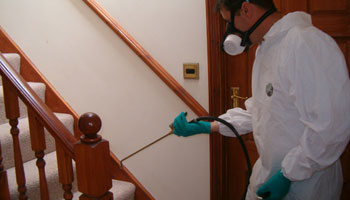
However, many of these chemicals are now banned under IS code, and the following emulsifiable chemicals are recommended:
- Heptachlor concentrate: 0.5% by weight
- Chlorpyrifos concentrate: 1.0% by weight
- Chlordane concentrate: 1.0% by weight
Pre-Construction Treatment for Termite-Proofing
Anti-termite treatment should start when the pits are ready to prevent the entry of subterranean termites into the buildings by creating a chemical barrier in the soil surrounding the construction premises. The various stages of anti-termite treatment carried out are as follows:
Stage 1 - During the site clearance, the termite hills found at the site location should be sprayed with chemicals.
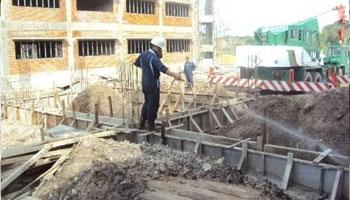
Stage 2 - Bottom and sides of trenches up to a height of 300 mm should be treated with Durmet solution at the rate of 5 litres per square metre of surface area.
Stage 3 - The refilled earth in contact with walls and columns should be treated with anti-termite chemicals for a width of 300 mm. About 3 to 5 litres per linear metre of the vertical surface should be used.
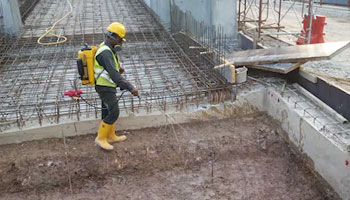
Stage 4 - After filling the earth up to plinth level for flooring, 50 to 70 mm deep holes should be drilled at 150 mm grid pattern. Treat these holes with the chemical solution at the rate of about 5 litres per square metre area.
Stage 5 - The junction of walls and floors should be treated at the rate of 15 litres per square metre of the wall surface.
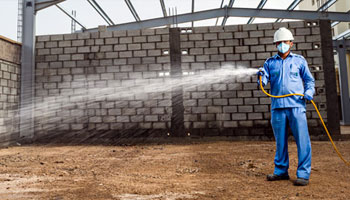
Stage 6 - After the completion of construction, holes 300 mm deep should be drilled along the external perimeter of the building at an interval of 150 mm. The holes should be filled with chemicals at the rate of 5 litres per metre length.
Stage 7 - Expansion joints and perimeters of pipes and conduits should also be treated with anti-termite chemicals.
Stage 8 - Before installing windows and doors in contact with masonry should be coated with two layers of paint.
Post Construction Treatment for Termite-Proofing
If termite growth is found in any building, post-construction treatment is required for termite-proofing. Pressure pumps are used to ensure proper chemical penetration, and the procedures are described below:
Outside walls around the building: If flagging concrete is present around the building, then holes of diameter 12 mm are drilled at distances of 300 mm and a chemical solution is pumped inside the holes. If there is no flagging concrete, then 500 mm deep holes are drilled at distances of 150 mm using iron rods and filled with chemicals.
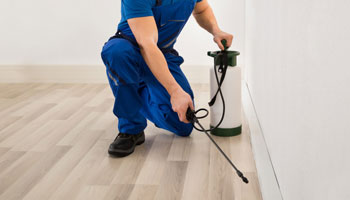
Soil under floor: For treating floor, walls, construction joints, cracks, etc.., holes of diameter 12mm are made 300 mm apart. These holes are pumped into soak the soil with a chemical solution of about 1 litre.
Treatment at plinth level: The holes are drilled on both sides of the wall at plinth level at an angle of 45¬° and a distance of 300 mm from the centre. The chemical solution is pumped in and after they are sealed with cement mortar in proportion 1:2.
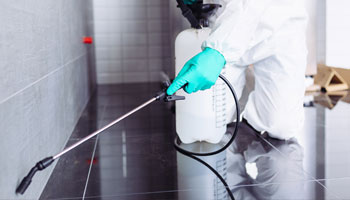
For better protection from termites, structural barriers can be provided with concrete or with metal sheets. Concrete barriers are more durable than metal barriers as they are likely to fail due to corrosion or other damage. Concrete barriers can be of 50-75 mm thick concrete extending about 50-75 mm on both sides of the plinth.
Termites have the potential to damage your building significantly. So, termite-proofing services are highly essential for any building to eliminate and dismantle termites attack and protect the wood interiors of the building.
Also, Check: Learn about the uses of Construction Chemicals




















